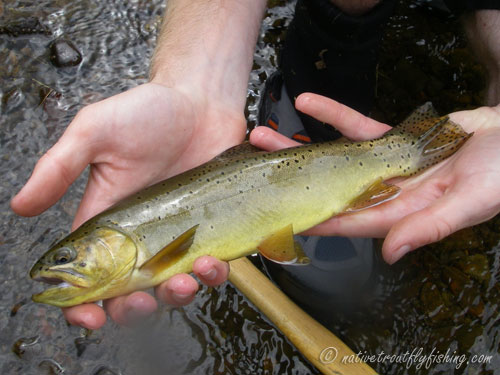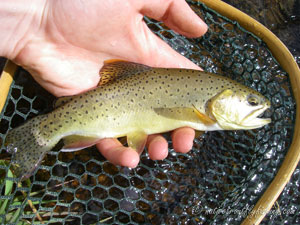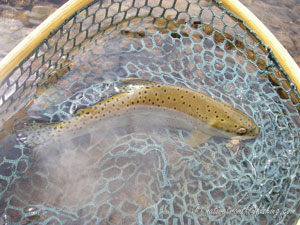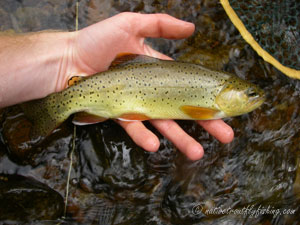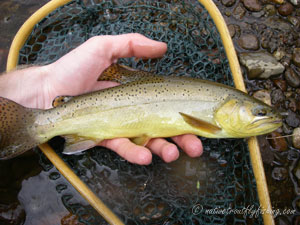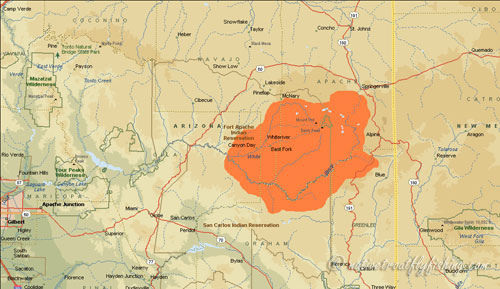Apache Trout
Oncorhynchus gilae apache
An Apache Trout from the White Mountains of Arizona.
Introduction
The Apache Trout are the state fish of Arizona and are native to the headwaters of the Black, White and Little Colorado Rivers in the White Mountains of Arizona. Apache Trout were first described as a full species Salmo apache in 1972 (Miller 1972), however, based on genetics are now considered a subspecies of Gila Trout, Oncorhynchus gilae apache (Behnke 2002). The distribution of the Apache Trout has been reduced to a fraction of its historic range, but recovery efforts have been largely successful and Apache trout now support a popular fishery in the White Mountains of Arizona.
Life History Information
The predominate life history displayed by the Apache Trout is the stream resident form, as virtually all remaining Apache Trout population restricted to high altitude headwater streams. Historically native Apache Trout did not get very large, with the average adult size in streams today ranging from 5” - 9” (13 - 23 cm). However when stocked into fertile lakes, these fish are known to reach sizes up to five pounds (2.25 kg) (AGFD 2001). Apache Trout are generalists, and their primary diet of consists of aquatic and terrestrial invertebrates. Although adult Apache Trout may live up to six years, the average life span is typically four years old (Behnke 2002).
Apache Trout are iteroparous and spawn during the spring (typically April to May), when stream temperatures rise to between 46°F and 47°F (7.8 to 8.3 °C) (USFWS 2009). Apache Trout typically spawn for the first time at an age of two to three years old, with males making up the bulk of the two-year-old fish. Females tend to seek out the downstream end of pools containing moderate sized cobble to construct their redds and Rinne (2001) showed that a 25% or greater amount of fine sediments greatly impacts successful emergence by fry. The average female will lay between 200 and 500 eggs with fry generally hatching after 30 days and emerging at around 60 days (AGFD 2001). After emerging, juvenile Apache Trout move to sections of the stream with cover and tend to seek out areas of streams with some sort of surfaces disturbance, or overhanging vegetation for protection from predators (Cantrell et al. 2005). Adult Apache Trout are primarily opportunistic drift feeders and prefer pool habitat and areas with slower moving water, instream woody debris or undercut banks and sufficient overhead cover (Petre and Bonar 2017).
Status
Apache Trout were historically native to approximately 600 miles of stream habitat, but suffered large scale declines over the last century. Prior to the start of recovery efforts Apache Trout were only found in around 30 miles of small headwater streams (Behnke 1992). This vast reduction in their range resulted in the Apache Trout being listed on the Endangered Species Act (ESA) along with the Gila Trout in 1973 (USFWS 1975). A variety of factors led to the decline of the Apache Trout, including overharvest, habitat destruction and most significantly the introduction of non-native trout.
As with many other isolated species of trout, the Apache Trout do not deal with introduced species well and non-native trout have played the largest role in their decline. Hybridization with both Rainbow and Cutthroat Trout has been the largest problem, and a 1993 study showed that out of 31 wild Apache Trout populations, only 11 showed no sign of hybridization (Carmichael et al. 1993). Due to the earlier emergence the fry of fall spawning Brook Trout and Brown Trout, these two introduced species typically out-compete Apache Trout, since there fry are able to establish territories before the Apache Trout have even spawned. Constructed barriers are often used as a management tool to separate Apache Trout populations from non-native trout populations, however these structures may fail allowing non-native fish to establish upstream and should be considered a short-term solution only (Robinson et al. 2004, Avenetti et al. 2006).
Beyond the issues caused by non-native trout, Apache Trout are also threatened by logging and overgrazing by livestock. These practices eliminate stream cover and also increase sedimentation, run-off, and stream temperatures due to a loss of riparian vegetation (Robinson et al. 2004). Although juvenile Apache Trout can survive short periods at temperatures up to 77 °F (25 °C), however if median temperatures are above 66 °F(19 C) Apache Trout experience reduced growth and survival (Recsetar et al. 2014). Additionally, as the preferred habitat for Apache Trout is deep pools with ample cover, these practices can be especially problematic. The increased sedimentation causes pools to fill in and lose for riparian habitat leads to a poor rate of regeneration of instream cover. Due to their coloration are easily spotted when out in the open and the availability of stream cover is thought to be very important for Apache Trout to be able to successfully avoid predators (Mesick 1988).
Today only around 35 populations, include four outside of their native range (Porath et al. 2010) of wild Apache Trout remain and the bulk of these are isolated in small headwater streams above barriers (TU 2009, USFWS 2009). While there has been a lot of progress in the restoration of the Apache Trout over the past half of a century, their abundance today is still a far cry from what it once was.
Description
The Apache Trout is most closely related to the Gila Trout and as such displays many similarities. The bodies of the Apache Trout tend to be deeper and more compressed when compared to other trout (Miller 1972). Generally the coloration of the Apache Trout is a brownish-olive to a bronze color on the back and transitions to a golden-yellow on the sides, with the color of the Apache Trout typically being brighter than that of Gila Trout. Like the Gila Trout, Apaches have relatively large fins and the dorsal fin on Apache Trout in particular is longer than that of any other western trout (Behnke 1992). The pelvic, anal and dorsal fins on the Apache Trout are tipped with white, although the dorsal may be tipped with orange. The spots on Apaches are moderately sized, fairly sparse and typically evenly distributed across the body. A distinctive trait in wild Apache Trout is a horizontal dark band of pigmentation across their iris that gives them a "bandit" look. Typically this trait is absent in hatchery reared Apache Trout.
Stream Resident Form
Click on images to view a larger picture
Native Range
A map of the original native range of the Apache trout. Data Source: Behnke (2002) and Propst et al. (1992).
References
AGFD. 2001. Heritage data management system, Apache trout. Arizona Game and Fish Department, Phoenix, AZ.
Avenetti, L.D., A.T. Robinson and C.J. Cantrell. 2006. Short-term effectiveness of constructed barriers at protecting Apache trout. North American Journal of Fisheries Management 26: 213-216.
Behnke, R. J. 1992. Native trout of western North America. American Fisheries Society Monograph 6. American Fisheries Society, Bethesda, Maryland.
Behnke, R.J. 2002. Trout and Salmon of North America. Chanticleer Press, New York.
Cantrell, C.J., Robinson, A.T. and Avenetti, L.D. 2005. Habitat selection by Apache trout in six East-Central Arizona streams. Transactions of the American Fisheries Society 134: 1382-1388.
Carmichael, G.J., Hanson, J.N., Schmidt, M.E. and Morizot, D.C. 2003. Introgression among Apache, cutthroat and rainbow trout in Arizona. Transactions of the American Fisheries Society 122: 121-130.
Mesick, C.F. 1988. Effects of food and cover on numbers of Apache and brown trout establishing residency in artificial stream channels. Transactions of the American Fisheries Society 117: 421-431.
Miller, R.R. 1972. Classification of the native trouts of Arizona with the description of a new species, Salmo apache. Copeia 1972(3): 401-422.
Petre, S.J. and S.A. Bonar. 2017. Determination of habitat requirements for Apache trout. Transactions of the American Fisheries Society 146: 1–15.
Porath, M.T., H.B. Blasius, J.A. Conn, K.L. Young and L.S. Jacks. 2010. Evaluating traslocation of the Apache trout (Oncorhynchus apache) to nonhistorical renovated streams. The Southwestern Naturalist 55(2): 229-239.
Recsetar, M.S. and S.A. Bonar. 2014. Growth and survival of Apache trout under static and fluctuating temperature regimes. Transactions of the American Fisheries Society 143(5):1247-1254.
Rinne, J.N. 2001. Effects of substrate composition on Apache trout fry emergence. Journal of Freswater Ecology 16(3): 355-365.
Robinson, A.T., L.D. Avenetti and C.J. Cantrell. 2004. Evaluation of Apache trout habitat protection actions. Arizona Game and Fish Department, Research Branch, Technical Guidance Bulletin No. 7, Phoenix, AZ.
Trout Unlimited. (2009). TU CSI - Apache trout. Retrieved February 5, 2010, from http://tucsi.spatialdynamics.com/ApacheTrout_General.aspx?SpKey=10
USFWS (U.S. Fish and Wildlife Service). 1975. Endangered and threatened wildlife and plants. Federal Register 40:44415-44429.
U.S. Fish and Wildlife Service. 2009. Apache trout recovery plan. Second Revision. Albuquerque, New Mexico.
Contact
Feel free to contact me if you have any questions or comments
Apache Trout Links
Arizona Department of Game and Fish - Apache Trout Angling
White Mountain Apache Trout - Fishing
Apache-Sitgreaves National Forests
Western Native Trout Initiative - Apache Trout
Native Trout Links
Truchas Mexicanas' - Native Trout of Mexico
Balkan Trout Restoration Group
Trout and Seasons of the Mountain Village - About Japanese Trout
Western Native Trout Challenge
California Heritage Trout Challenge
Fly Fishing Blogs
Dave B's Blog: Fly Fishing for Native Trout
The Search for Native Salmonids
Conservation Links
Western Native Trout Initiative
Fly Fishing Links
Fishing Art Links
Americanfishes.com - Joseph R. Tomelleri
